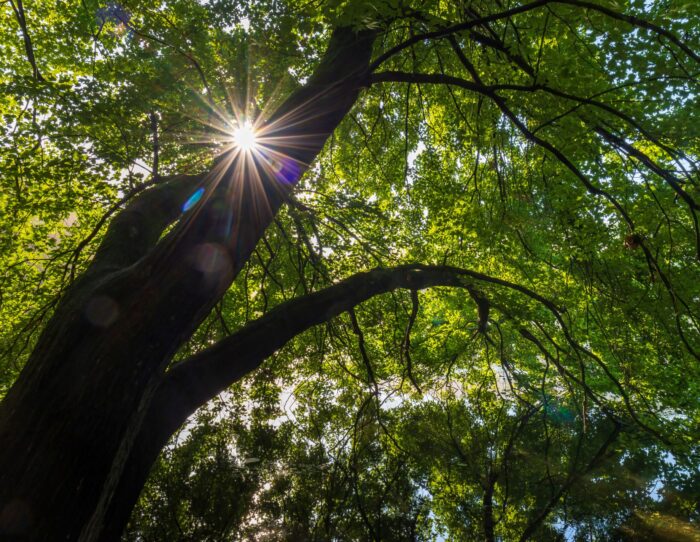As a nature photographer, I’m hyper-aware of the shifting light throughout the day, including the magical “golden hour” just before sunrise and sunset. The right lighting can make a big difference to photo quality. Even before I got into photography, I’d always loved watching the play of light and shadow on water or sifting through leaves. Both natural light and the lights that we kindle can be powerful points of spiritual connection.
I find inspiration and solace in nature as well as ancient texts, sharing insights and practices based around the four ancient elements of earth, water, air, and fire. Each of these are ready gateways to foster connection with nature, tradition, and our inner lives. With the fourth post in this series, I’m considering fire and the light it produces.
On a physical level, sunlight is necessary for life on earth. On a spiritual level, light has a universal meaning of goodness, hope, and healing. In The Encyclopedia of Jewish Symbols, Ellen Frankel and Betsy Platkin Teutsch describe light as a pervasive symbol in Jewish theology and tradition, “the primary link between divine and human worlds.”
God’s first act of creation is to declare, “Let there be light!” Light is a symbol of Torah, “For a commandment is a lamp, and Torah is light.” (Proverbs 6:23). Light has a moral association; the people of Israel are called upon to be an ethical example, “a light unto the nations” (Isaiah 49:6). For the mystics, the Divine can be described as Ohr Ein Sof, a boundless light beyond our comprehension yet concealed within all creation.
Lighting candles is a big part of Jewish life. The Midrash wonders why God commands us to light lamps in the Mishkan (and by extension in our own homes) when God already created the sun, moon, and stars to illuminate the world. Surely the Creator of Light does not need our candles! Exodus Rabbah 36:2 teaches that the command is not for God’s benefit, but for ours. God says, “Not because I need your light do I tell you to light lamps before Me, but so that you may give light to Me, just as I gave light to you.” The Infinite Light invites us to become partners in illumination.
We light Shabbat candles on Friday evening and a Havdalah candle at its conclusion. Candles are lit on the eve of festivals, and of course many candles or oil lights are lit for Hanukkah. I recall my Sephardic mother-in-law floating oil candles on Rosh Hodesh (the new moon) in memory of righteous people.
Each Jewish candle has its own purpose. Shabbat candles provide lighting for the Shabbat meal, harmony in the home, and today, when we have electric lights, a special more “golden” atmosphere. The Havdalah candle inaugurates the week with lighting a fire, something traditionally forbidden on Shabbat. For me, the sight of its braided flame and torch-like fire evokes the Torah’s descriptions of the burning bush in which God appeared to Moses or the pillar of fire through which God appeared to the Israelites (Exodus 13:12), bringing the story of the Exodus into my life. The custom of gazing at hands in the flame reminds me to dedicate the use of our hands in the week to come, the use of fire for good purposes like warming and nourishing others.
Hanukkah lights have a different purpose. They are not for lighting the home but are placed in a window to “publicize the miracle” of the holiday (which is much more than the little jug of oil, but the miracle of survival, faith, and triumph against the odds). I find a lot of meaning in the unspoken message of candles or oil lights increasing from day to day, from the idea of “lighting a single candle rather than curse the darkness” to the growing light of fellowship and community.
In remembering departed loved ones, we light a large shiva candle and subsequently light smaller Yahrzeit candles every year, recalling that “God’s candle is the human soul” (Proverbs 20:27). By lighting the candle, we bring the person’s life into our world, a light that, like the flame, we can contemplate and admire but not physically touch.
Lighting candles seems to be a universal impulse, whether to set a mood, focus attention, or commemorate. (As I write this, it is the first day of Diwali, the Hindu festival of lights.) This summer, on a visit to Denmark, I learned that for Danes, lighting candles any time of day is a big part of making life “hygge,” an untranslatable term connoting an atmosphere of coziness, contentment, and friendship essential to their culture.
For a mystical teaching on candles, I turn to Rabbi Aryeh Kaplan, a great modern Torah scholar and physicist who pioneered modern Jewish meditation based on ancient sources. In his books Inner Space and Jewish Meditation: A Practical Guide, Kaplan used the metaphor of a candle flame to represent the soul’s five levels, based on Kabbalah. The black base of the flame represents Nefesh, the physical, animating soul. The blue of the flame represents Ruach, the emotional soul. The bright glow of the flame represents the Neshamah, or higher spiritual consciousness. The surrounding aura of the flame represents Chaya, a transcendent level of soul encountered rarely in this lifetime, one that I would call “destiny.” Finally, there is Yechidah, the Divine Unity. Beyond the individual candle, it is the One who lights them all. It’s simultaneously the spark of God planted like a seed in each of us, while also the transcendent divine source beyond-the-beyond.
My teacher, Rabbi Zalman Schachter-Shalomi, loved to share this ancient Midrash:
Rabbi Shimon ben Yehozadak asked Rabbi Shmuel bar Nachman, saying: “Since I hear that you are a master of Aggadah [sacred lore], tell me how light was created.”
Rabbi Shmuel bar Nachman replied: “God wrapped God-self in a white garment, and the radiance of God’s majesty illuminated the world from one end to the other.”
Now he had answered him in a whisper, and so the former observed, “There is a verse which states it explicitly: ‘You wrap yourself with light as with a garment’ (Psalm 104:2), yet you say it in a whisper!”
“Just as I heard it in a whisper, so have I told it to you in a whisper,” he replied.
Two Practices with Light and Fire
Outdoors
Everyday experiences, from sunrise every morning to glimpsing the night sky, can assume miraculous importance when we approach them with awe and reverence.
Next time you see beautiful light outdoors in nature, instead of walking by or even grabbing your phone for a photo, pause to take it in, to let the light and its colors enter your soul. You can even take a cue from the Midrash above and try whispering, “You wrap Yourself with light as with a garment.”
Indoors
When you light a candle for Shabbat, Hanukkah, or personal meditation, take a few moments to gaze into the flame until you can discern the different levels of color and illumination. Imagine a light glowing inside of you as the dimensions of your soul: Nefesh (vital life force), Ruach (creative spirit), Neshamah (higher spiritual awareness and contemplation), and even the connection to Chaya and Yechidah, the higher dimensions of soul that represent destiny and divine unity. As you contemplate the light, sense your inner light connected to the divine light that illuminates the world. Slow down and feel your inner and outer glow. Lighting Shabbat and holiday candles is also a traditional time to say personal prayers for loved ones or send them a blessing.
When obtaining candles, it’s healthier and more ecologically sound to choose beeswax, soy, or coconut oil with natural (or no) scents, rather than a petroleum-based paraffin. Make sure the room has ventilation and never leave a candle unattended.
*Photo taken by Rabbi Julie Hilton Danan, https://wellspringsofwisdom.com

